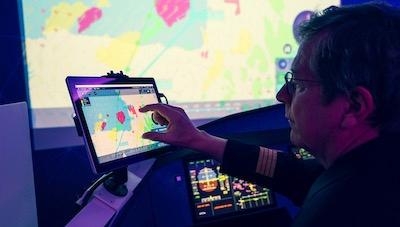Software Has Been Designed To Capitalize On The Greater Availability Of Data
Thales is unveiling PureFlyt, a Flight Management System (FMS) specifically designed to efficiently manage aircraft in a connected aerospace ecosystem and in increasingly crowded skies.

With the global commercial aircraft fleet forecast to double by 2030, and the use of drones set to rapidly grow, we will be entering an era in which millions of aircraft movements are recorded each day. Combining extensive knowledge of Avionics, Connectivity, Air Traffic management and 40-year Flight Management System expertise, Thales has developed PureFlyt, an entirely connected FMS, to offer airframers and airlines the best combination of safety, security, and fuel and operations efficiency.
PureFlyt will allow crews to make better decisions using more sources of information, will bring improved performance and reactivity to the aircraft during complex phases of flight and will calculate alternative trajectories in real time to propose or react quickly to changes of plan. Providing pilots with the right information at the right time heightens trust in the computed trajectory, enhancing efficiency and reducing pilot workload throughout all flight phases.
One of the core innovations making PureFlyt a game changer in the FMS world is its ability to draw on both onboard and open-world data, such as weather information. By combining the integrity of the FMS and the agility and power of Electronic Flight Bag flight functionalities, aircraft trajectory can be permanently controlled, adapted and enhanced, resulting in optimized flight, decreased fuel consumption and improved passenger comfort.
While being a technological breakthrough, PureFlyt enjoys an unparalleled maturity level. Using massive testing and artificial intelligence technologies to simulate 2 billion test cases enabled accumulating an invaluable experience, equivalent of 100 million actual flight hours.
Cyber-secure by design, PureFlyt has also been designed to be future-proof, accommodating the implementation of concepts such as the Initial 4D (I4D) trajectory management methods currently being researched by SESAR (Single European Sky ATM Research) in the EU and NextGen in the US. By increasing the accuracy of flight in four dimensions, the fourth dimension being time, PureFlyt will enable more effectiveness in maintaining optimal distance between aircraft, particularly in the demanding phases of departure and approach.
“In the air, the digital revolution has only just begun. A paradigm shift in onboard cockpit electronics is taking place in the connected airspace and PureFlyt is at the forefront of this digital new age, leading the next generation of Flight Management System that truly makes the aircraft a node of connectivity. By computing and sharing vast amounts of data, PureFlyt will make flights safer, greener, easier for the pilots to manage, more profitable for airlines and, all this, ultimately for the full benefits of passengers,” said Jean-Paul Ebanga, Thales vice-president Flight Avionics.
PureFlyt will be available for entry into service in 2024, for both linefit and retrofit.
(Image provided with Thales Group news release)
 Aero-TV: DeltaHawks Diesel Power Steps Into the Spotlight
Aero-TV: DeltaHawks Diesel Power Steps Into the Spotlight NTSB Prelim: Mooney Aircraft Corp. M20K
NTSB Prelim: Mooney Aircraft Corp. M20K ANN FAQ: Turn On Post Notifications
ANN FAQ: Turn On Post Notifications ANN's Daily Aero-Linx (12.20.25)
ANN's Daily Aero-Linx (12.20.25) Aero-News: Quote of the Day (12.20.25)
Aero-News: Quote of the Day (12.20.25)



